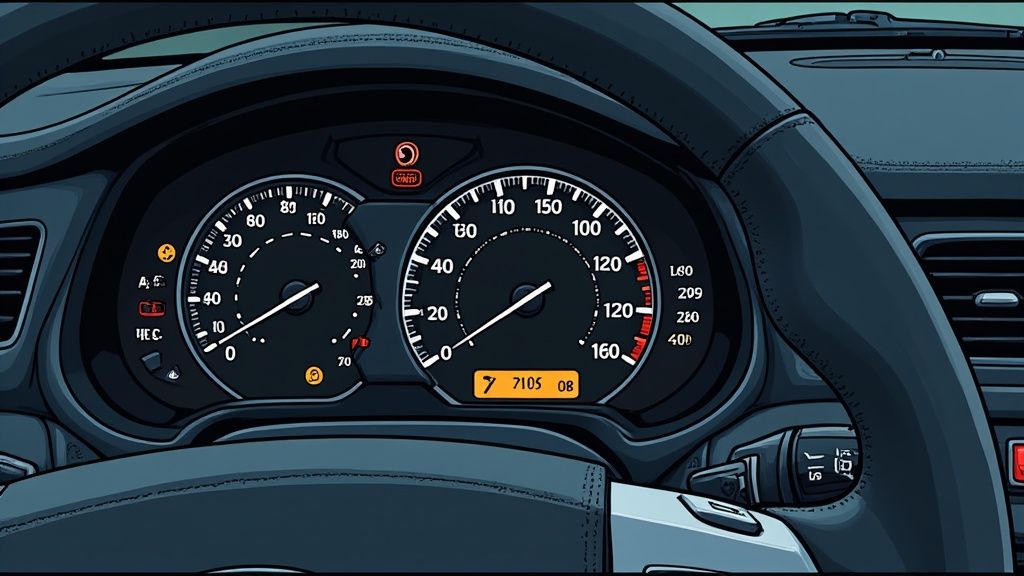
How to Track Car Maintenance: The Ultimate Digital and Manual Strategy Guide
Why Smart Maintenance Tracking Really Matters

Keeping detailed records of your track car maintenance isn’t just about staying organized - it directly affects your vehicle’s performance, lifespan, and future sale value. Just like maintaining a health record helps doctors understand your medical history, a thorough maintenance log gives you clear insights into your car’s condition over time. This documentation becomes especially important when you decide to sell your vehicle.
How Tracking Impacts Resale Value
Good maintenance records can substantially increase what buyers are willing to pay for your car. Toyota has found that following recommended service schedules leads to better resale prices compared to similar vehicles lacking maintenance history. For instance, documented proof of regular oil changes and tire rotations gives buyers confidence that the car has been well-maintained, making them more likely to pay a premium. Rather than viewing maintenance tracking as just another task, consider it an investment that pays off when it’s time to sell.
What Matters Most to Buyers
While all maintenance records are valuable, certain service details catch buyers’ attention more than others. Regular oil changes stand out as a key indicator of responsible ownership. Though 3,000-mile oil changes were once standard, modern engines and improved oil quality now allow for longer intervals - typically 5,000 to 7,500 miles, sometimes up to 15,000 miles based on manufacturer guidelines. Recording these changes and the type of oil used shows you’ve properly cared for the engine.
Tire maintenance records are another priority for buyers. Documenting regular rotations and pressure checks demonstrates proactive care. Studies show proper tire pressure alone can boost fuel efficiency up to 3% on highways and 1.3% in city driving. These details matter to buyers because they indicate consistent preventative maintenance.
Avoiding Costly Tracking Mistakes
Many owners make the mistake of skipping records for smaller maintenance tasks. Even basic services like topping off fluids deserve documentation since they show attention to detail. Another common error is having gaps in repair records - missing paperwork for major work can make buyers suspicious of hidden problems. Think of your maintenance log as telling your car’s complete story - each record builds trust and supports the vehicle’s value. By avoiding these tracking oversights and maintaining thorough documentation, you’ll be better positioned to get top dollar when selling while giving buyers the confidence they need to make an offer.
Building Your Essential Maintenance Checklist
Keeping a track car running smoothly requires much more attention than a regular road car. Track driving puts extreme stress on every component through high speeds, aggressive braking, and intense cornering forces. To stay on top of maintenance needs and keep your car performing safely, you need a detailed checklist specifically designed for track use.
Understanding Service Intervals
The manufacturer’s maintenance schedule in your owner’s manual is just a starting point for track cars. For example, while normal street driving might allow 7,500 miles between oil changes, track use can require changes every other track day or even after each race weekend. The intense heat and stress of track driving breaks down engine oil much faster, risking engine damage if not changed frequently. You might be interested in: How to master your track car maintenance schedule.
Factoring in Driving Conditions and Usage
The specific demands of your track and driving style heavily impact maintenance needs. Running long straights at high speeds creates different wear patterns compared to technical courses with many corners. More aggressive driving also means more frequent service intervals. It’s similar to running shoes - sprinting every day wears them out much faster than casual jogging.
Creating Your Personalized Checklist
Here’s a basic track car maintenance checklist to adapt for your specific vehicle:
| Component | Service Interval | Inspection Points |
|---|---|---|
| Engine Oil & Filter | Every Track Day or Every Other Track Day | Check oil level and consistency |
| Brake Pads & Fluid | Every 2-3 Track Days | Inspect pad thickness, check fluid level and condition |
| Tires | Every Track Weekend or Sooner | Check for wear and tear, proper inflation |
| Cooling System | Every 3-4 Track Days | Check coolant level and condition |
| Suspension | Every 4-5 Track Days | Inspect for leaks, damage, and proper function |
| Drivetrain | Every Season | Check for leaks, noises, and vibrations |
Early Warning Signs
Your car will often tell you when something isn’t right, both on and off track. Strange noises, vibrations, or changes in how the car handles can signal developing problems. For instance, if your brake pedal feels spongy, you may have air in the brake lines. Engine knocking could mean worn bearings. Catching these issues early prevents them from becoming major failures. After each track session, thoroughly inspect your car for loose hardware, fluid leaks, and other damage. This proactive approach helps avoid unexpected breakdowns and keeps repair costs down.

Choosing the Right Digital Tools for Your Needs

Managing your track car maintenance requires more than just a basic checklist - you need the right digital tools to stay organized and on top of service schedules. While paper notes might work for basic tracking, modern digital solutions offer significant advantages for comprehensive maintenance management. The key is finding the right tool that matches your specific needs and maintenance style.
Finding the Right Fit: Basic vs. Comprehensive
For some track car owners, a simple reminder app provides enough functionality to stay on schedule. These basic apps let you set alerts based on elapsed time or track days rather than just mileage - perfect for tracking maintenance intervals specific to track use. However, basic reminder apps often lack detailed record-keeping capabilities that many track car owners need.
This is where platforms like Auto Service Logger become valuable. These full-featured tools create a central hub for all maintenance records, allowing you to log every service, store receipts, and monitor expenses over time. The detailed tracking helps identify patterns in your car’s maintenance needs and diagnose recurring problems. For example, you can generate complete service histories that provide documentation for insurance or resale purposes. This thorough approach ensures you maintain clear records of all work performed on your track car.
Key Features to Consider
When evaluating maintenance tracking tools, certain capabilities are essential. The ability to set custom service intervals based on track days rather than just mileage allows you to match maintenance to your actual usage patterns. This flexibility helps you properly maintain your car based on how you drive it.
Detailed documentation features are also crucial. Look for tools that let you upload photos of receipts, parts, and completed work. This thorough documentation proves invaluable for warranty claims and demonstrates the quality of maintenance to future buyers. Cloud storage capabilities are another important consideration, as they keep your records secure and accessible from any device.
Integrating Digital Tools Into Your Routine
The real value of maintenance tracking tools comes from consistent use. Make it a habit to log services, upload documentation, and update records right after each track day while details are fresh in your mind. Many apps offer mobile features so you can update information trackside. Think of your digital tools as part of your pit crew - always ready to record important maintenance data.
However, be selective with notifications to avoid alert overload. Configure your settings to notify you only of critical maintenance items so you stay focused on what matters. When you choose the right tool and develop good recording habits, digital tracking becomes a natural part of your maintenance routine rather than an extra task. This systematic approach helps protect your investment while maximizing both performance and enjoyment at the track.
Creating a Bulletproof Paper Trail

Physical documentation remains critical for track car maintenance, even in our digital age. Just like doctors maintain both electronic and paper records, having tangible proof of your vehicle’s service history protects your investment and makes warranty claims easier. A well-organized documentation system pays off in multiple ways over time.
Organizing for Success: A System That Works
Start by creating a simple but effective filing system. A three-ring binder with clearly labeled dividers for different maintenance categories (engine work, brakes, suspension, etc.) provides an excellent foundation. File all receipts and paperwork chronologically within each section for quick reference. For example, if you need to find records of a brake service from two years ago, you can locate it in minutes. This organization becomes increasingly valuable as your maintenance history grows.
Make your records more useful by adding detailed notes to accompany receipts. Include the service date, mileage reading, specific parts used, and observations about performance before and after maintenance. These extra details provide valuable context that basic receipts can’t capture. This level of detail impresses potential buyers and shows the genuine care invested in maintaining your track car.
Documentation That Adds Value: Beyond the Basics
Strengthen your maintenance records by including supporting materials beyond standard receipts. Take photos of worn or replaced parts to provide visual evidence of necessary work. For example, photographing worn brake pads alongside the replacement receipt clearly validates the repair. Performance upgrade documentation, such as dyno testing results showing power gains, adds further credibility to your records.
Consider keeping a log of track events, including dates, locations, and performance data. This information helps tell your car’s complete story and demonstrates its capabilities. Good documentation transforms basic maintenance records into a detailed history of your track car’s development. You might be interested in: How to master your track car maintenance schedule.
Winning Over Buyers and Insurance: The Power of Proof
Thorough documentation delivers real benefits when selling your car or handling insurance matters. A complete maintenance history shows responsible ownership and supports asking for top dollar. According to Toyota, well-documented maintenance significantly boosts resale value. Buyers feel more confident purchasing a car with clear service records, often leading to faster sales at better prices.
Detailed records also streamline insurance claims. Having organized documentation of repairs and maintenance helps claims adjusters process your case more efficiently and fairly. This preparation saves time and reduces stress during difficult situations. Insurance companies value thorough records just as much as potential buyers do. By maintaining comprehensive documentation, you protect your investment and demonstrate your commitment to proper track car care.
Maximizing Performance Through Smart Tracking
Proper track car maintenance involves much more than basic upkeep. When you track your maintenance systematically, you can improve performance, avoid breakdowns, and make your vehicle last longer. By monitoring key indicators over time, you can spot potential issues early and fix them before they become major problems.
Understanding the Performance Impact of Diligent Tracking
Regular tracking lets you monitor essential metrics like lap times, braking performance, and tire temperatures. By analyzing these numbers over time, you can identify subtle changes that might signal developing problems. For instance, if your lap times start creeping up consistently, it could mean your brake pads are wearing down or your engine needs attention. Catching these signs early helps you address issues quickly and minimize time spent in the garage.
Optimizing Maintenance Schedules Through Data Analysis
The data you collect through maintenance tracking provides clear insights into how your car wears over time. This information helps you create a personalized maintenance schedule based on your actual driving patterns rather than following generic recommendations. You’ll know exactly when to perform services based on real usage data, which means doing maintenance at the right time - not too early or too late. This focused approach helps maintain peak performance while controlling costs.
Predictive Maintenance: Anticipating Issues Before They Arise
When you track maintenance consistently, you can start to predict when components will need attention. By monitoring trends in oil consumption, tire wear patterns, and brake pad life, you’ll develop a good sense of when parts typically need replacement. This helps you plan ahead and schedule service before problems occur, much like professional racing teams do. You can avoid unexpected issues during track days and plan maintenance at convenient times.
Enhancing Reliability and Longevity Through Proactive Care
Cars that receive consistent, data-driven maintenance simply last longer and perform better. By addressing small issues promptly based on your tracking data, you’ll spend more time enjoying your car on the track and less time dealing with repairs. Regular maintenance also protects your investment by maintaining the car’s value over time. Think of it like healthcare for your vehicle - routine checkups and early intervention prevent minor issues from becoming serious problems. Just as racing teams rely on detailed maintenance records to keep their cars competitive, you can use tracking to get the most from your track car for years to come.
Building Your Long-Term Maintenance Strategy
A successful track car maintenance program requires more than just completing random repairs - it needs a thoughtful, long-term approach. By combining digital and manual tracking methods while adapting to your car’s evolving needs, you can protect your investment and prevent major issues. The key is developing systems that work seamlessly with your schedule.
Creating a Sustainable Maintenance Routine
The best maintenance routines fit naturally into your existing schedule rather than feeling like extra work. One effective method is connecting maintenance tasks to activities you already do. For instance, make tire pressure checks part of your standard pre-track day preparations along with packing your gear. This helps maintenance become an automatic habit.
Breaking larger jobs into smaller pieces also makes maintenance more manageable. Instead of getting overwhelmed by a full suspension rebuild, tackle it as a series of smaller tasks over time. This approach helps you make steady progress while keeping the work from becoming too daunting.
Setting Up Effective Reminder Systems
While reminders are essential for staying on track with maintenance, the key is finding a system that matches your preferences. Some drivers do well with basic calendar alerts, while others prefer specialized maintenance apps. Test different approaches to determine what consistently keeps you on schedule.
Be careful not to overload yourself with too many reminders though. Focus on alerts for truly critical items to avoid “notification fatigue” that leads to ignoring important maintenance prompts. A targeted reminder strategy helps you stay focused on top priorities.
Adapting Your Strategy Over Time
As your car accumulates miles and your driving style develops, maintenance needs shift accordingly. New cars often require frequent attention to wear items like brakes and tires. But with higher mileage, suspension and drivetrain maintenance becomes increasingly important. Regular assessment helps you adjust your maintenance schedule to match your car’s current condition.
Analyzing your maintenance records can reveal important patterns. For example, increasing oil consumption might signal the need for more frequent oil changes or indicate developing engine problems. These insights let you address issues proactively before they become major repairs. Learn more in our guide on How to master your track car maintenance schedule.
The Payoff: Preventing Costly Repairs
A well-planned maintenance strategy protects your investment by catching problems early. Many track car owners have saved thousands of dollars by identifying and fixing minor issues before they turned into major failures. For example, a small oil leak that gets ignored could eventually lead to catastrophic engine damage. Consistent monitoring and timely maintenance prevents these expensive scenarios.
Ready to make track car maintenance simpler and more effective? Auto Service Logger provides comprehensive service tracking, receipt storage, and expense monitoring to support your long-term maintenance strategy. Start your free trial today and experience the confidence of having your car’s complete maintenance history at your fingertips: https://autoservicelogger.com/